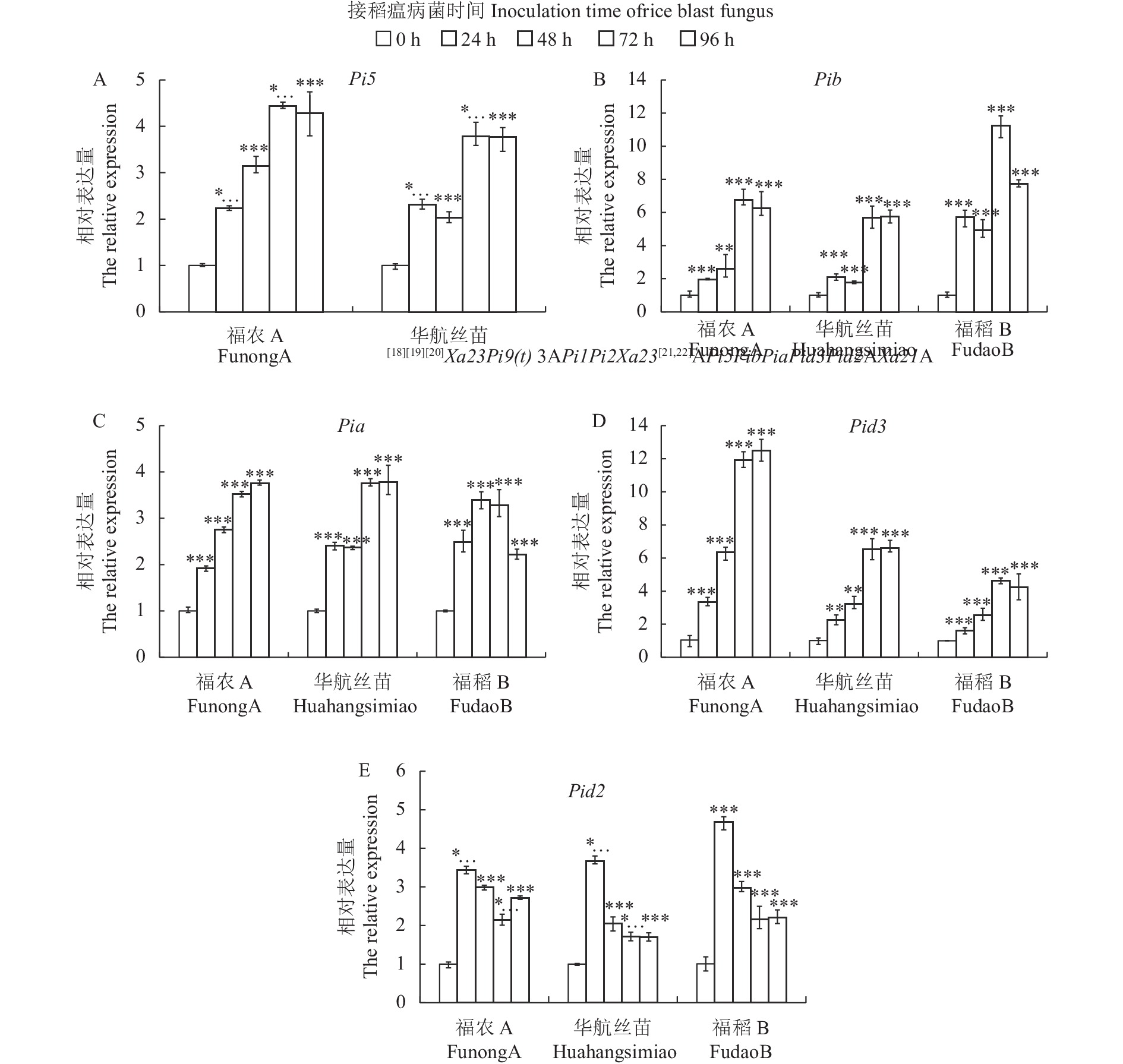Disease and Insect Resistance Genes in Premium Sterile Line Funong A
-
摘要:
目的 分析福农A中的抗病虫基因,为该不育系更好地应用于育种生产提供理论依据。 方法 以福农A及亲本福稻B、华航丝苗为材料,利用抗稻瘟病基因分子标记检测各材料中抗稻瘟病基因情况,并应用高密度芯片检测抗白叶枯病、抗病毒及抗褐飞虱基因情况。PCR扩增获得福农A及亲本福稻B、华航丝苗中的抗稻瘟病基因,进行序列比对分析。植株培养至三叶一心期,喷雾接稻瘟病菌并取样,采用 SYBR Green I 荧光定量 PCR(qRT-PCR) 分析抗稻瘟病基因的表达模式。 结果 福农A及亲本福稻B、华航丝苗中均含有稻瘟病抗性基因Pib、Pia、Pid3和Pid2,但均不含Pi9、Pi54、Pigm、Pit、Pi2;另外,福农A和华航丝苗中含有Pi5,而福稻B中含有Pita和Pi37。福农A及亲本福稻B和华航丝苗中均含有抗白叶枯病基因Xa21和抗黄色斑驳病毒病基因Rymv1;福农A及华航丝苗中含持久性抗水稻条叶枯病毒基因STV11;但它们中均不含抗褐飞虱基因Bph14、Bph15、Bph18、 Bph26、 Bph6、 Bph9。扩增获得的 Pi5、Pia、Pib、Pid3、Pid2基因序列长分别为5 672、2 597、5 532、2 865、 3847 bp;福农A与亲本华航丝苗中的Pi5基因序列完全一致;福农A和亲本华航丝苗、福稻B中的Pia、Pib基因序列均完全一致;福农A和华航丝苗中的Pid3和Pid2基因序列完全一致,而它们与福稻B的序列分别有2个和5个碱基差异。在福农A中,抗稻瘟病基因Pi5和Pib的表达明显受稻瘟病菌的诱导,接菌72 h时表达量最高;Pia和Pid3的表达随接菌时间的延长而逐渐升高,接菌96 h时表达量最高;Pid2的表达先升高后降低,且在接菌24 h时表达量最高。结论 水稻三系不育系福农A中含有稻瘟病抗性基因Pi5、Pib、Pia、Pid3和Pid2,抗白叶枯病基因Xa21、抗黄色斑驳病毒病基因Rymv1及持久性抗水稻条叶枯病毒基因STV11。因此,该不育系有望应用于多抗基因的聚合育种研究。 Abstract:Objective Disease and insect resistance genes in Funong A, a three-line indica cytoplasmic male sterile line, were analyzed for breeding applications. Method Genomic DNA of Funong A, Fudao B, and Huahangsimiao rice germplasms was extracted by CTAB method followed by detection of blast resistance genes with molecular markers. Resistance genes related to bacterial blight, viral diseases, and brown planthopper infestation were analyzed by high density chip detection method. Blast resistance genes of the lines were obtained by PCR and sequenced for comparison. Specimens were collected at 0, 24, 48, 72, and 96h after a blast fungus inoculation for extraction of total RNA using Trizol method. Gene expression was determined by SYBR Green I qRT-PCR. Result Funong A, Fudao B, and Huahangsimiao were found to contain the blast resistance genes Pib, Pia, Pid3, Pid2, bacterial blight resistance gene Xa21, and yellow mottle virus resistance gene Rymv1. Furthermore, Funong A and Huahangsimiao had the blast resistance gene Pi5 and the stripe virus resistance gene STV11, while Fudao B consisted of the blast resistance genes Pita and Pi37. However, no brown planthopper resistance genes were detected in them. The fragments of Pi5, Pia, Pib, Pid3, and Pid2 were 5,672 bp, 2,597 bp, 5,532 bp, 2,865 bp, and 3,847 bp in length, respectively. The sequences of Pi5, Pid3, and Pid2 in Funong A were similar to those in Huahangsimiao, but 2 bases differed from Pid3 and 5 from Pid2 of Fudao B. In Funong A, the expressions of rice blast resistance genes Pi5 and Pib were significantly induced by the blast fungus with a peak occurred 72h after inoculation. The expressions of Pia and Pid3 increased gradually with time after inoculation to peak in 96h. The expression of Pid2 rose initially to a maximum in 24h and then declined. Conclusion The three-line indica cytoplasmic male sterile line Funong A carried the blast resistance genes Pi5, Pib, Pia, Pid3, and Pid2, which were significantly induced by the blast fungus. The line also contained the bacterial blight resistance gene Xa21, yellow mottle virus resistance gene Rymv1, and stripe virus resistance gene STV11 but none of the insect resistance genes. -
Key words:
- Funong A /
- blast resistance gene /
- sequential analysis /
- gene expression
-
表 1 PCR及qRT-PCR引物
Table 1. Primers for PCR and qRT-PCR
引物
Primers引物序列(5′-3′)
Primer sequence(5′-3′)片段大小(抗/感)
Fragment size(Resistance/Susceptibility)/bp参考文献
ReferencePibdom F:GAACAATGCCCAAACTTGAGA 365 (R) /无 (S) [9] R:GGGTCCACATGTCAGTGAGC Pi9 F:GCTGTGCTCCAAATGAGGAT 291 (R) / 397 (S) [10] R:GCGATCTCACATCCTTTGCT Pi5 F:ATAGATCATGCGCCCTCTTG 206 (R)/307 (S) [10] R:TCATACCCCATTCGGTCATT Pi54 F:CAATCTCCAAAGTTTTCAGG 216 (R)/359 (S) [11] R:GCTTCAATCACTGCTAGACC Pita F:CTCCCTTGTTCGGTCAAAAA 467 (R)/850 (S) [10] YL155:AGCAGGTTATAAGCTAGGCC R:CCACATTGATGAAGCCCATA Pia F:GCGACTGACACTTTCAATAGC 175 (R)/206 (S) [12] R:CGGTAGAGCAATTTAGAAGCAG Pigm F:CAGAGCAGTAACAAACCCTA 750 (R)/ 1800 (S)[13] R:TCCGCAAGATCAACATTC Pit F:ATGATAACCTCATCCTCAATAAGT 733(R)/无 (S) [14] R:GTTGGAGCTACGGTTGTTCAG Pid3 F:TACTACTCATGGAAGCTAGTTCTC BamHI, 148 (R)/ 178 (S) [15] R:AGCACTTCTTGACTACTGTCTGCCT Pi2 F:CAGCGATGGTATGAGCACAA 450 (R)/ 282 (S) [10] R:CGTTCCTATACTGCCACATCG Pi37 F:TCTTGAGGGTCCCAGTGTAC 1149 (R)/无(S)[16] R:CGAACAGTGGCTGGTATCTC Pid2 F:GCGTCGAAGATGTCCTGAAGCTCA 629(R)/无 (S) [17] R:GGCAGTCGTATTGCTGTGAA Pi5-DNA F: CCTTCTCTCTTCTCGTTCTCCTATTTCACA 5672 R: CAGTTGGTTTCTTGTAGGATTACAGGTCAGT Pia-DNA F:ACATTTTAGTCAACTCGCCTGTTCTTTT 2597 R:CAATCAGAAAGCAACAGGTCCAAATAAC Pib-DNA F:ACAAAATCCATTCAAAAATAGAACAGAGCA 5532 R:CACAGCCCCTCGGGTCCACAT Pid3-DNA F:AAGCGAGAAGGAAGTAACACCCAAGG 2865 R:AAGAATGAATGTCCTGACTGAAACCAACT Pid2-DNA F:CTGGGTTTGAAGAAAAGAATAAAGGGAGTG 3847 R:TGAAAATGATACTGAAAGGTCTGATGAAAA Pi5-qPCR F:TTCTGCTCGCTATCCAATCCAATG 173 R:TTTCTGTATGATGTTGTTTGCTTCTCCTC Pia-qPCR F:CCAGCCACTTGCTCTTGTTACCATAG 134 R:GCCGCATCCTTTCAAGTGTTTTATCA Pib-qPCR F:GGACAAGTGTTGGTGCTTCGGAG 176 R:CCTTGGGCTTTGATAAACACCGCT Pid3-qPCR F:AAGCAGTGGAGGTCGCCAAGTC 138 R:CGTCCTTGAACCGCTCGGCT Pid2-qPCR F:ACTAACTTCTTCCCTCCTGCGGCT 175 R:AAGATGCGAAACGAGTTGTATTCCC Actin150 F:AGTGTCTGGATTGGAGGAT 147 R:TCTTGGCTTAGCATTCTTG 表 2 抗病虫基因分析结果
Table 2. Analysis on disease and insect resistance genes
基因名称
Genes染色体
Chromosome表型
Phenotype探针类型
Probe type福农A
FunongA福稻B
FudaoB华航丝苗
Huahangsimiaoxa13 8 白叶枯抗性 单倍型 0.08 0.08 0.22 Xa21 11 白叶枯抗性 单倍型 1.00 1.00 1.00 Xa23 11 白叶枯抗性 单倍型 0.07 0.10 0.07 xa5 5 白叶枯抗性 单倍型 0.35 0.31 0.35 Xa7 6 白叶枯抗性 单倍型 0.11 0.44 0.11 Rymv1 4 抗黄色斑驳病毒病 SNP √ √ √ STV11 11 持久性抗水稻条叶枯病毒 SNP √ √ Bph14 3 褐飞虱抗性 单倍型 0.48 0.55 0.34 Bph15 4 褐飞虱抗性 单倍型 0.16 0.16 0.16 Bph18 12 褐飞虱抗性 单倍型 0.69 0.59 0.69 Bph26 12 褐飞虱抗性 单倍型 0.52 0.43 0.52 Bph6 4 褐飞虱抗性 单倍型 0.62 0.62 0.62 Bph9 12 褐飞虱抗性 单倍型 0.40 0.28 0.40 表格中探针类型为“SNP”的基因,样品编号下方的“√”表示与代表品种基因型一致,空格表示未检测到相关基因;表格中探针类型为“单倍型”的基因,样品编号下方的数字表示与标准样对比的相似度,“1.00”表示与标准样相似度达100%,样品中存在该基因。
For genes with probe type "SNP", a "√" sign under the code indicates a genotype consistent with reference, while without a sign, no related gene detected. For genes with probe type "haplotype",number represented similarity to reference sequence, and "1.00" indicates a 100% similarity to reference as gene existed in the sample. -
[1] 刘倩, 张国豪, 车万均, 等. 杂交水稻重要亲本农艺性状配合力遗传力分析 [J]. 广东农业科学, 2020, 47(1):1−8.LIU Q, ZHANG G H, CHE W J, et al. Analysis on combining ability and heritability in agronomic traits of key parents of hybrid rice [J]. Guangdong Agricultural Sciences, 2020, 47(1): 1−8. (in Chinese) [2] 曹厚明, 晚莉, 袁驰, 等. 优质抗病香型籼稻三系不育系内香10A的选育与应用 [J]. 杂交水稻, 2023, 38(6):62−66.CAO H M, WAN L, YUAN C, et al. Breeding and application of aromatic indica CMS line Neixiang 10A with good grain quality and disease resistance [J]. Hybrid Rice, 2023, 38(6): 62−66. (in Chinese) [3] 张云虎, 严志, 杨力, 等. 利用分子标记辅助选择技术改良三系不育系荃9311A稻瘟病抗性的研究 [J]. 杂交水稻, 2022, 37(1):19−24.ZHANG Y H, YAN Z, YANG L, et al. Studies on improving rice blast resistance of CMS line Quan 9311A by molecular marker-assisted technology [J]. Hybrid Rice, 2022, 37(1): 19−24. (in Chinese) [4] 涂诗航, 连玲, 洪永河, 等. 籼型三系不育系‘福农A’的选育及其综合农艺性状分析 [J]. 农业生物技术学报, 2024, 32(3):701−711.TU S H, LIAN L, HONG Y H, et al. Breeding of the three-line indica cytoplasmic male sterile line ‘funong a’ and its comprehensive agronomic trait analysis [J]. Journal of Agricultural Biotechnology, 2024, 32(3): 701−711. (in Chinese) [5] 谢旺有, 陈锦文, 谢少和, 等. 高产中抗稻瘟病杂交水稻新组合福农优039的选育 [J]. 杂交水稻, 2022, 37(6):64−66.XIE W Y, CHEN J W, XIE S H, et al. Breeding of new hybrid rice combination funongyou 039 with high yield and moderate blast resistance [J]. Hybrid Rice, 2022, 37(6): 64−66. (in Chinese) [6] 黄伟群. 优质、抗病杂交稻福农优9802在南平市示范表现及高产栽培技术 [J]. 福建稻麦科技, 2020, 38(4):46−48.HUANG W Q. Demonstration of plant performance and high-yielding cultivation techniques of good quality and disease resistance hybrid rice combination funongyou 9802 in Nanping City [J]. Fujian Science and Technology of Rice and Wheat, 2020, 38(4): 46−48. (in Chinese) [7] 陈锦文, 陈惠清, 李坤泰, 等. 优质抗病水稻新品种福农优404的选育[J]. 福建农业学报, 2022, 37(3): 283-290.CHEN J W, CHEN H Q, LI K T, et al. Breeding a high-quality, disease-resistant rice, funong you 404[J]. Fujian Journal of Agricultural Sciences, 2022, 37(3): 283-290. (in Chinese) [8] 丁巧莲. 优质抗病杂交稻福农优101在建阳区种植表现及高产栽培技术 [J]. 福建稻麦科技, 2021, 39(3):58−60.DING Q L. Planting performance and high-yielding cultivation techniques of Funongyou 101 in jianyang district [J]. Fujian Science and Technology of Rice and Wheat, 2021, 39(3): 58−60. [9] FJELLSTROM R, CONAWAY-BORMANS C A, MCCLUNG A M, et al. Development of DNA markers suitable for marker assisted selection of three Pi genes conferring resistance to multiple Pyricularia grisea pathotypes [J]. Crop Science, 2004, 44(5): 1790−1798. doi: 10.2135/cropsci2004.1790 [10] 高利军, 高汉亮, 颜群, 等. 4个抗稻瘟病基因分子标记的建立及在水稻亲本中的分布 [J]. 杂交水稻, 2010, 25(S1):294−298.GAO L J, GAO H L, YAN Q, et al. Establishment of markers for four blast genes and marker distribution in rice parents [J]. Hybrid Rice, 2010, 25(S1): 294−298. (in Chinese) [11] RAMKUMAR G, SRINIVASARAO K, MOHAN K M, et al. Development and validation of functional marker targeting an InDel in the major rice blast disease resistance gene Pi54 (Pikh) [J]. Molecular Breeding, 2011, 27(1): 129−135. doi: 10.1007/s11032-010-9538-6 [12] OKUYAMA Y, KANZAKI H, ABE A, et al. A multifaceted genomics approach allows the isolation of the rice Pia-blast resistance gene consisting of two adjacent NBS-LRR protein genes [J]. The Plant Journal, 2011, 66(3): 467−479. doi: 10.1111/j.1365-313X.2011.04502.x [13] 梁毅, 杨婷婷, 谭令辞, 等. 水稻广谱抗瘟基因Pigm紧密连锁分子标记开发及其育种应用 [J]. 杂交水稻, 2013, 28(4):63−68,74.LIANG Y, YANG T T, TAN L C, et al. Development of the molecular marker tightly-linked with the broad-spectrum blast resistance gene pigm and its breeding practice in rice [J]. Hybrid Rice, 2013, 28(4): 63−68,74. (in Chinese) [14] HAYASHI K, YASUDA N, FUJITA Y, et al. Identification of the blast resistance gene Pit in rice cultivars using functional markers [J]. TAG Theoretical and Applied Genetics Theoretische und Angewandte Genetik, 2010, 121(7): 1357−1367. doi: 10.1007/s00122-010-1393-7 [15] SHANG J J, TAO Y, CHEN X W, et al. Identification of a new rice blast resistance gene, Pid3, by genomewide comparison of paired nucleotide-binding site: Leucine-rich repeat genes and their pseudogene alleles between the two sequenced rice genomes [J]. Genetics, 2009, 182(4): 1303−1311. doi: 10.1534/genetics.109.102871 [16] 孙庚. 水稻抗瘟基因与稻瘟菌无毒基因的分布及稻瘟菌分子检测[D]. 长春: 吉林大学, 2012.SUN G. Distribution of resistance genes in rice and avirulence genes in rice blast fungus and molecule detection of Magnaporthe oryzae [D]. Changchun: Jilin University, 2012. (in Chinese) [17] 高利军, 邓国富, 高汉亮, 等. 水稻抗稻瘟病基因Pi-d2基因标签的建立与应用 [J]. 西南农业学报, 2010, 23(1):77−82. doi: 10.3969/j.issn.1001-4829.2010.01.017GAO L J, DENG G F, GAO H L, et al. Establishment and application of gene tagging linked to rice blast resistance gene Pi-d2 [J]. Southwest China Journal of Agricultural Sciences, 2010, 23(1): 77−82. (in Chinese) doi: 10.3969/j.issn.1001-4829.2010.01.017 [18] DENG Y W, ZHAI K R, XIE Z, et al. Epigenetic regulation of antagonistic receptors confers rice blast resistance with yield balance [J]. Science, 2017, 355(6328): 962−965. doi: 10.1126/science.aai8898 [19] 陈贤, 赵延存, 明亮, 等. 水稻白叶枯病抗性相关基因的研究进展 [J]. 江苏农业学报, 2022, 38(5):1402−1410.CHEN X, ZHAO Y C, MING L, et al. Update of rice bacterial blight resistance genes [J]. Jiangsu Journal of Agricultural Sciences, 2022, 38(5): 1402−1410. (in Chinese) [20] 黄振, 彭勇, 杨定照, 等. 优质三系杂交水稻新品种隆晶优8129的选育 [J]. 湖南农业科学, 2023(10):15−18.HUANG Z, PENG Y, YANG D Z, et al. Breeding of a new quality three-line hybrid rice longjingyou 8129 [J]. Hunan Agricultural Sciences, 2023(10): 15−18. (in Chinese) [21] 宋丰顺, 倪金龙, 张爱芳, 等. 水稻两系不育系1892S抗白叶枯病和抗稻瘟病分子改良 [J]. 分子植物育种, 2016, 14(6):1507−1515.SONG F S, NI J L, ZHANG A F, et al. Molecular improvement of male sterile line 1892S for resistance to rice blast and bacterial blight [J]. Molecular Plant Breeding, 2016, 14(6): 1507−1515. (in Chinese) [22] 柳武革, 王丰, 李金华, 等. 水稻三系不育系的分子设计改良与应用 [J]. 广东农业科学, 2021, 48(10):69−77.LIU W G, WANG F, LI J H, et al. Improvement of three-line rice male sterile lines by molecular design and their application [J]. Guangdong Agricultural Sciences, 2021, 48(10): 69−77. (in Chinese) -








 下载:
下载:





